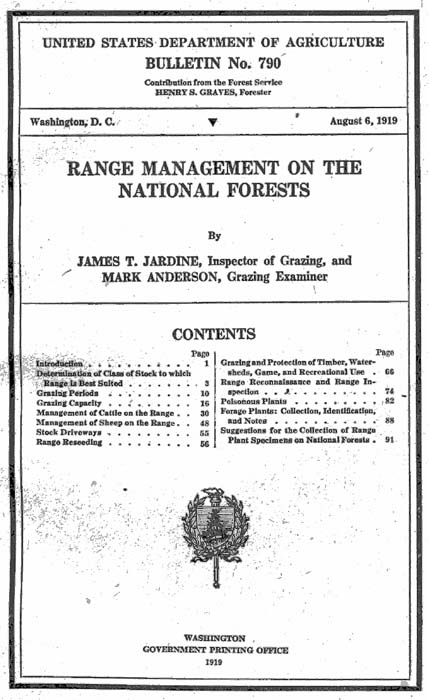Range Management bulletin

James T. Jardine and Mark Anderson's Bulletin No. 790 (Washington, D.C.: Government Printing Office, August 6, 1919) has long been considered a classic work on national forest grazing for its affirmation of the agency's utilitarian principles, but also for its mature view of the need to regulate grazing in accord with the needs of timber and water protections, wildlife, recreation, and the condition of the range itself. The publication's Introduction begins as follows:
"In the administration of the National Forests the aim is to convey to the greatest possible number the full benefit of all the resources which the Forests contain and at the same time to perpetuate these resources by regulating their use. Accordingly, grazing on the National Forests is regulated with the object of using the grazing resources to the fullest extent possible consistent with the protection, development, and use of other resources.
As the National Forests were established primarily for the protection and development of the Forests and the protection of the watersheds, great pains must be taken to harmonize grazing with these primary purposes. Also, as plans go forward for the development and use of new range and for more complete utilization of all unused areas within the ranges now in use, more and more care must be exercised to see that the wild life of the Forests is not unduly restricted. As long as a large portion of each Forest was unused by domestic stock the main feature of game protection was proper regulation of hunting; but with grazing reaching out to the pockets and corners, the problem of insuring forage and secluded spots for game becomes more complicated. The recreational features of the National Forests, too, are of increasing importance, and increased attention is necessary to harmonize grazing use with recreational use."
Due to budgetary restrictions which at the time limited government agricultural publications to 100 pages, a considerable amount of material was deleted from the final publication. The bulletin checks in at exactly 100 pages, but managed to include an additional 32 pages of black and white photo plates.
U.S. Forest Service Headquarters History Collection

